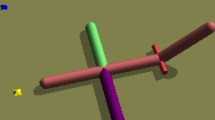Abstract
In this paper, we describe Lichtsuchende, an interactive installation, built using a society of biologically inspired, cybernetic creatures who exchange light as a source of energy and a means of communication. Visitors are invited to engage with the installation using torches to influence and interact with the phototropic robots. As well as describing the finished piece, we explore some of the issues around creating works based on biologically inspired robots. We present an account of the development of the creatures in order to highlight the gulfs between conceptual ideas of how to allow emergent behaviours and the manners in which they are implemented. We also expose the interrelations and tensions between the needs of the creatures as they emerge and the needs of the creators, to understand the duet between the cyber-organisms and their initiators. Finally, we look at the ways in which creators, robots and visitors are enrolled to perform their functions, so that the network of activity can be woven between all parties.
Thanks to the Innovative Initiative Fund of the University of Edinburgh.
Access this chapter
Tax calculation will be finalised at checkout
Purchases are for personal use only
Similar content being viewed by others
Notes
- 1.
- 2.
- 3.
The work won the 3rd place Public Choice Award at the 2014 New Technological Art Awards (http://www.ntaa.be/2014/).
- 4.
Roughly: \(d\theta _{lr}/dt \sim i_l - i_r\) where \(\theta _{lr}\) is the pan or horizontal alignment of the head, and \(i_l\) and \(i_r\) are the intensities of the left and right sensors respectively, with a similar relation holding for the vertical (tilt) orientation. However, tweaks have been made to stabilise this in an effort to improve the interactivity.
- 5.
The modification to the general simplex algorithm is largely to cover the idea that moving to a new point to sample it is expensive, while actually evaluating the objective function is cheap.
References
Blackwell, T.: Swarm music: improvised music with multi-swarms. In: 2003 AISB symposium on AI and Creativity in Arts and Science, pp. 41–49 (2003)
Miranda, E.R.: On the evolution of music in a society of self-taught digital creatures. Digital Creativity 14(1), 29–42 (2003)
Fong, T., Nourbakhsh, I., Dautenhahn, K.: A survey of socially interactive robots. Rob. Autonom. Syst. 42(3), 143–166 (2003)
Barlow, G.W.: Modal action patterns. In: Sebeok, T.A. (ed.) How Animals Communicate, pp. 98–136. Indiana University Press, Bloomington (1977)
Maslow, A.H.: A theory of human motivation. Psychol. Rev. 50(4), 370–396 (1943)
Brooks, R.A.: A robust layered control system for a mobile robot. Rob. Autom. 2(1), 14–23 (1986)
Moffat, D., Frijda, N.H.: Where there’s a will there’s an agent. In: Wooldridge, M.J., Jennings, N.R. (eds.) ECAI-94. LNCS, vol. 890, pp. 245–260. Springer, Heidelberg (1995)
Merrick, K.E., Maher, M.L.: Towards the future. In: Merrick, K.E., Maher, M.L. (eds.) Motivated Reinforcement Learning, pp. 193–199. Springer, Heidelberg (2009)
Von Uexküll, J.: A Foray into the Worlds of Animals and Humans. University of Minnesota Press (2010)
Ingold, T.: The Perception of the Environment: Essays on Livelyhood, Dwelling and Skill. Routledge, London (2000)
Callon, M.: Some elements of a sociology of translation: domestication of the scallops and the fishermen of St Brieuc Bay. In: Law, J. (ed.) Power, Action, and Belief: A New Sociology of Knowledge?, pp. 196–223. Routledge & Kegan, London (1986)
Anderson, P.W.: More is different. Science 177(4047), 393–396 (1972)
Nagel, T.: What is it like to be a bat? Philos. Rev. 83, 435–450 (1974)
Nelder, J.A., Mead, R.: A simplex method for function minimization. Comput. J. 7(4), 308–313 (1965)
Latour, B.: Give me a laboratory and I will raise the world. In: Biagioli, M. (ed.) The Science Studies Reader, pp. 258–275. Routledge, New York (1999)
Acknowledgments
This work is supported under SOCIAM: The Theory and Practice of Social Machines, a programme funded by the UK Engineering and Physical Sciences Research Council (EPSRC) under grant number EP/J017728/1, and a collaboration between the Universities of Edinburgh, Oxford, and Southampton.
Author information
Authors and Affiliations
Corresponding author
Editor information
Editors and Affiliations
Rights and permissions
Copyright information
© 2015 Springer International Publishing Switzerland
About this paper
Cite this paper
Murray-Rust, D., von Jungenfeld, R. (2015). Lichtsuchende: Exploring the Emergence of a Cybernetic Society. In: Johnson, C., Carballal, A., Correia, J. (eds) Evolutionary and Biologically Inspired Music, Sound, Art and Design. EvoMUSART 2015. Lecture Notes in Computer Science(), vol 9027. Springer, Cham. https://doi.org/10.1007/978-3-319-16498-4_15
Download citation
DOI: https://doi.org/10.1007/978-3-319-16498-4_15
Published:
Publisher Name: Springer, Cham
Print ISBN: 978-3-319-16497-7
Online ISBN: 978-3-319-16498-4
eBook Packages: Computer ScienceComputer Science (R0)




